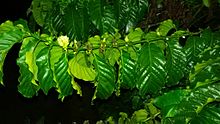Region: Asia
Roast: Medium
Our Eyes Wide Open is sourced from India and it is a Robusta bean with naturally double the caffeine!!
Coffea canephora (syn. Coffea robusta), commonly known as robusta coffee, is a species of coffee that has its origins in central and western sub-Saharan Africa. It is a species of flowering plant in the family Rubiaceae. Though widely known as Coffea robusta, the plant is scientifically identified as Coffea canephora, which has two main varieties, robusta and nganda.
Robusta is a species of flowering plant in the family Rubiaceae. Though widely known by the synonym Coffea robusta, the plant is currently scientifically identified as Coffea canephora, which has two main varieties, C. c. robusta and C. c. nganda. The plant has a shallow root system and grows as a robust tree or shrub to about 10 m tall. It flowers irregularly, taking about 10–11 months for cherries to ripen, producing oval-shaped beans.
The robusta plant has a greater crop yield than that of arabica, contains more caffeine (2.7% compared to arabica's 1.5%), and contains less sugar (3–7% compared to arabica's 6–9%). As it is less susceptible to pests and disease, robusta needs much less herbicide and pesticide than arabica.
Native distribution
Originating in upland forests in Ethiopia, C. canephora grows indigenously in Western and Central Africa from Liberia to Tanzania and south to Angola. It was not recognized as a species of Coffea until 1897, over a hundred years after Coffea arabica. It is also reportedly naturalized in Borneo, French Polynesia, Costa Rica, Nicaragua, Jamaica and the Lesser Antilles.[7] In 1927 a hybrid between robusta and arabica was found in Timor. This strain was subsequently used to breed rust-resistant plants.
Cultivation and use
Robusta coffee is coffee made from beans of the plant Coffea canephora, a sturdy species with low acidity and high bitterness. C. canephora beans, widely known by the synonym Coffea robusta, are used primarily in instant coffee, espresso, and as a filler in ground coffee blends.
Some 37% to 40% of the coffee produced in the world is robusta. It is mostly grown in Vietnam, where French colonists introduced it in the late 19th century, though it is also grown in Africa and Brazil, where it is often called conilon. In recent years, Vietnam, which produces mostly robusta, has surpassed Brazil, India, and Indonesia to become the world's single largest exporter of robusta coffee. Brazil is still the biggest producer of coffee in the world, producing one-third of the world's coffee, though 80% of that is C. arabica.
Robusta has its origins in central and western sub-Saharan Africa. It is easy to care for, has a greater crop yield, has almost double the amount of caffeine and more antioxidants, and is less susceptible to disease than arabica coffea. It represents up to approximately 40% of global coffee production, with arabica constituting the remainder.
It is mostly grown in Vietnam, where French colonists introduced it in the late 19th century, though it is also grown in India, Africa and Brazil, where it is often called conilon. In recent years, Vietnam, which produces mostly robusta, has become the world's largest exporter of robusta coffee, accounting for over 40% of the total production. It surpasses Brazil (25% of the world's production), Indonesia (15%), India (6%), and Uganda (4.5%). Brazil is still the biggest coffee producer in the world, producing one-third of the world's coffee, though 70% of that is C. arabica.
Robusta is easier to care for and has a greater crop yield than C. arabica, so is cheaper to produce. Roasted robusta beans produce a strong, full-bodied coffee with a distinctive earthy flavour, but usually with more bitterness than arabica due to its pyrazine content. Since arabica beans are believed to have smoother taste with more acidity and a richer flavour, they are often considered superior, while the harsher robusta beans are mostly used as a filler in lower-grade coffee blends. However, the powerful flavour can be desirable in a blend to give it perceived "strength" and "finish", noticeably in Italian coffee culture. Good-quality robusta beans are used in traditional Italian espresso blends, at about 10–15%, to provide a full-bodied taste and a better foam head (known as crema). It is besides used as a stimulant, diuretic, antioxidant, antipyretic and relieves spasmodic asthma.



